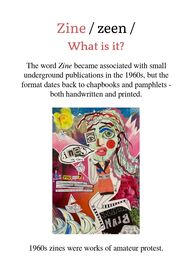
Return to flip book view
The word Zine became associated with smallunderground publications in the 1960s, but theformat dates back to chapbooks and pamphlets -both handwritten and printed.Zine / zeen /What is it?1960s zines were works of amateur protest. Message
Yes, Merriam-Webster took the word zine in1946 and the Oxford followed in 1949. It had theassociation of being cool, up-to-date, andfashionable, or ‘hip’ in black American slang; so,it was not a new coinage in the 1960s. Itoriginally came from a contraction of fanzine inthe 1930s among science-fiction and alternativemusic lovers. Only later did it become a vehiclefor political protest and alternative lifestyles. ACT UP! DROP OUT!A zine is self-published in a limited edition –fewer than 100 copies and often no more than adozen or two if handwritten. They are not-for-profit publications intended to provideinformation to a variety of protesters.And, historically, what do Protestants do? Well... er ... they protest.Is ‘Zine’ in the dictionary?
Publications of ProtestThe rise of literacy among ordinary people isdue, in part, to the spread of panflets oropuscules in late medieval Europe. Theseopuscules appeared on single sheets of paper andcould be innocent fairy tales or seditiouschallenges to authority.Later, the printing press fuelled the spread ofinformation and protest.
The Political andReligious Pamphlet
The English Civil WarPamphlets Pamphleteers More Pamphlets called Battle of Bumf
Zines as Creative ChallengesHow did you copy or print your zines?Office Duplicators used wax templates intowhich you scratched or typed your designs andprinted them in black ink on a mucky old hand-cranked Roneo or Gestetner rotary office copier.
Photocopiers gradually replaced officeduplicators or mimeographs during the 1950sand 1960s. The first photocopiers used liquidchemicals and the wet copies had to dry - likephotos from the darkroom.Xerox replaced liquid copiers in the 1960s withtheir dry method of reproducing documents andimages. The word xerography is coined fromGreek and means ‘dry writing.’Xerox started as a photographic company in1906 and developed their first photocopier in1961. This invention made them one of theworld’s richest companies. The companychanged its name from Haloid Xerox to simplyXerox in 1961.So, Zine-makers and self-publishers had amethod of copying rather than printing. Theysimply needed to prepare a matrix or master toslap on the plate of a photocopier.Photocopiers
A home computer with a printer gives usersdesktop publishing capabilities. Indeed, you canmake your own books and cards and zines.Reach out in print rather than through socialmedia. Be creative. Be mindful.Anyhow, a laser printer works in a mannersimilar to a photocopy: the printed text andimages are fused into the paper.Inkjets squirt ink onto the paper and are clevercreatures but five to ten times more expensive torun than a laser. Also the inks are dyes whichfade unless you use costly pigment inks.Do you need colour? Creators of zines in the olddays might colour their images by hand.Colouring is calming and meditative. The job of‘colourist’ existed for decades.The PC and Printer and DTP
Adana Hobby LetterpressThis may be overlooked but not forgotten. It is ahobby home printing press called Adana,pronounced [aˈ da na]Search on Wiki for Adana_Printing_MachinesThey are therapeutic.
Russians are intoself-publishingThey have a word for it in Russian:самиздат samizdatRussians are an oppressed people who manage tocirculate forbidden news in hard copy. Digitalpublications can be traced by the cyber-censors,so hand-printing is safer. In Russia, samizdat isnot a hobby, it is a deadly serious undertakingand can land you in jail.
FreedomsNot to be taken for granted ...
Make a BookYou’ve got it in you.San Paper www.sansap.comSteve Mongkutsanpaper@proton.meOctober 2023